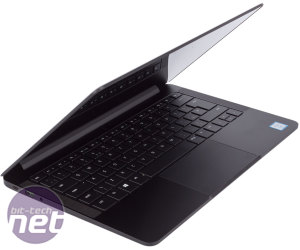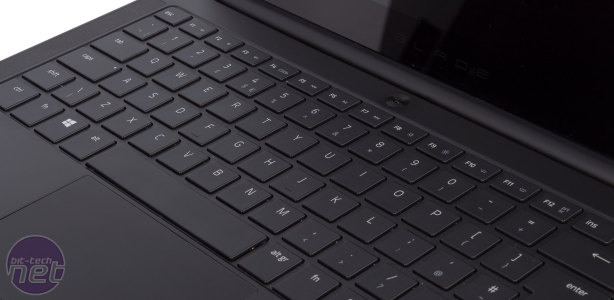Performance Analysis
For our games testing, we selected the EVGA GTX 1080 FTW since a powerful card would more clearly show CPU limitations and it's fairly likely a user with enough cash to drop on this laptop and the Core would opt for a high-end card like this. We compared results obtained with the Core to those gathered using our standard Z170-based GPU test system which sports a 4.5GHz Core i7-6700K.The good news is that gaming at 1080p and 1440p is solid, with the Blade Stealth and Core combination pumping out smooth frame rates with ultra settings in DX11 and DX12 titles. The bad news, however, as you will have seen from the charts, is that the Core i7-7500U really isn't powerful enough for gaming, and clearly limits the GTX 1080, sometimes to an alarming degree: in the best case (Fallout 4 at 1440p) the average frame rate compared to a Core i7-6700K was only 19 percent less, but in the worst case (Battlefield 1 at 1080p) it more than halved, dropping from 123fps to 59fps. There are potentially bandwidth limitations in play from the Thunderbolt 3 connection, but a CPU limit seems far more likely, especially as the effect is more apparent at 1080p and in the DX12 title – DX12 is specifically designed to utilise the CPU more effectively. An overclocked Core i7-6700K is perhaps an unfair or extreme comparison, and less powerful cards would likely be less affected, but the difference still highlights that the CPU here isn't up to the task.
3DMark confirms what we suspected, with significantly lower scores using the Razer Blade Stealth and Core, and 1080p and DX12 seeming to be more affected. Looking at the individual tests, the CPU-bound portions are far more affected than the GPU-bound ones.
We also put the Blade Stealth and Core through VRMark. With a GTX 1080, the setup passed the Orange Room test, indicating its suitability for Oculus Rift or HTC Vive headsets. However, the average frame rate was still way below what we saw on an actual desktop system. Both setups failed the Blue Room test, which is simply too demanding for modern GPUs.
The mobile dual-core CPU does have an impressive amount of grunt for demanding day-to-day tasks like photo or video editing, at least, as evidenced by the PCMark 8 results, where the video editing result is particularly strong for a CPU of this class. More punishing tasks, however, where the cores are thrashed, such as in rendering, are too much for this CPU to deal with and the Cinebench and Terragen 3 scores are far behind everything else we have in the charts. That's understandable, however – this is an ultrabook, not a workstation, and you'd be a moron to use it primarily for tasks like this.
The storage testing highlights the write speed weakness of the Samsung PM951 256GB SSD, but the read speed is pretty strong, as is random performance. Ultimately, it delivers the goods when it comes to loading games and isn't too shabby in heavier tasks either.
Display performance, at least as measured by our colorimeter, is very respectable for the most part. The contrast ratio was measured at around 700:1 and there's plenty of brightness on tap (around 275cd/m2). Conversely, the screen can also get extremely dim – at the lowest setting we measured just 11cd/m2 and the black point was unmeasurable.
Elsewhere, we see full RGB gamut coverage, and near-ideal gamma and white point results of 2.1 and 6,800K respectively. Similarly, colour accuracy is, for the most part, excellent: A delta E result below 2 is very strong. Uniformity, both in terms of luminance and colour, is a little off, and the weakest point as far as the measurements go. That said, gauging the impact of this with our own eyes was difficult because of the screen's glossiness: Inconsistent ambient light is going to make a much bigger difference to perceived uniformity than the display itself ever will. It's a shame because when the lighting is right, the screen really does look great, with the high PPI giving exceptional sharpness to images and colours and blacks looking accurate but not oversaturated.
Applying consistent load to the CPU saw it reach 97°C, very close to its maximum 100°C operating temperature, pretty quickly, at which point the fans span up fast and the throttling kicked in, with the CPU then settling at around 85°C with the fans audible but non-intrusive. The laptop clearly has tightly controlled thermals, which makes sense and even though it isn't designed to have the CPU hammered like this (most workloads come in quick bursts), it handled it well.
Battery life, at six hours and 41 minutes in the PCMark 8 conventional test, was excellent, and far beyond other laptops we've looked at (admittedly there aren't any ultrabooks in the charts). The combination of an ultra-efficient Kaby Lake CPU and LPDDR3 is clearly a good one, and as mentioned the battery has a high capacity, but we should note that we test at minimum brightness here and the Razer panel is not really usable at its zero percent setting – even Razer recommends 20 percent as a minimum – so this probably gave it a boost too. That said, we did keep the Chroma effects running on the keyboard, and this is one area where you could easily save some extra power. Either way, there's plenty of juice in this tank, and the battery charges fairly quickly as well.

MSI MPG Velox 100R Chassis Review
October 14 2021 | 15:04











Want to comment? Please log in.